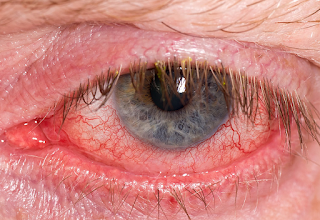How to Make Your Eyes White Again…Safely
Many patients ask me, “How can I make My Eyes Whiter?” The real question they are asking is how can I make my eyes whiter safely. We know that Phenylephrine (which is in Visine) will blanch the blood vessels, but Visine can cause rebound redness that in some patients is worse than the original redness. Steroids also help but long term steroid use has the risk or cataract formation & glaucoma which is optic nerve damage and has the risk of blindness.
The key thing is to find the underlying cause of the redness or lack of whiteness and treat that first.
Here is more information.
Sandra Lora Cremers, MD, FACS
All eyeMDs know that anything with Phenylephrine will blanch the conjunctiva (which is the clear saran wrap covering of the white wall of the eye=sclera) and some of the scleral blood vessels and make the eye appear whiter if there is no scleritis (inflammation of the sclera).
Phenylephrine is a selective α1-adrenergic receptor agonist of the phenethylamine class used primarily as a decongestant, as an agent to dilate the pupil, constrict blood vessels (in the eye or in the body if taken by mouth), and to increase blood pressure. Frequent use of Phenylephrine can cause rebound redness (the redness comes back with a vengeance in some patients). [Too much Pheylephrine by mouth can cause a decrease in heart rate through reflex bradycardia (slow heart rate).]
Thus, Pheylephrine, though used in some Visine formulations, is not a good drug to keep using in your eye.
More natural options are as follows:
1. Stay hydrated– drinking more 64oz of water per day
2. Eat plenty of green leafy veggies like spinach, lettuce, collard greens. Also eat other veggies like carrots, radishes
3. Avoid smoking
4. Avoid liver or kidney disease which can cause jaundice or yellowing of the eyes.
5. Avoid getting Hepatitis or any other inflammatory conditions
6. Avoid getting diabetes
7. Avoid the sun: wear sunglasses always when outside. Excess sun exposure starting at a young age can cause blood vessels to grow and form a Pinguecula or grow over your cornea and create a Pterygium. Photos are below:PINGUECULA: Growth not on Cornea PTERYGIUM: Growth onto Cornea
PTERYGIUM: Growth onto Cornea
8. Use Cold artificial tears may help constrict blood vessels in some patients: Ice covered in a cloth also helps constrict blood vessels to help decrease redness which often can be due to:
a. Allergy: anti-allergy drops may help get rid of redness
b. Dry Eyes: treat any burning or signs of dryness (burning, tearing, itching, redness) ag gressively. Use my dry eye regimen may help. https://drcremers.com/2016/10/best-treatment-for-dry-eyes-eye-redness.html
gressively. Use my dry eye regimen may help. https://drcremers.com/2016/10/best-treatment-for-dry-eyes-eye-redness.html
c. Blepharitis: bacteria or mites on eyelashes which irritate eyes.
9. Drops with Pheylephrine will only temporary fix the redness and can cause rebound redness: try to avoid as much as possible.
10. New Treatment for Red Eyes: A patient brought in this:
- Acute inflammation of the liver – may impair the ability of the liver to conjugate and secrete bilirubin, resulting in a buildup.
- Inflammation of the bile duct – may prevent the secretion of bile and removal of bilirubin, causing jaundice.
- Obstruction of the bile duct – prevents the liver from disposing of bilirubin.
- Hemolytic anemia – production of bilirubin increases when large quantities of red blood cells are broken down.
- Gilbert’s syndrome – an inherited condition that impairs the ability of enzymes to process the excretion of bile.
- Cholestasis – a condition where the flow of bile from the liver is interrupted. The bile containing conjugated bilirubin remains in the liver instead of being excreted.
More rare conditions that may cause jaundice include:
- Crigler-Najjar syndrome – an inherited condition that impairs the specific enzyme responsible for processing bilirubin
- Dubin-Johnson syndrome – an inherited form of chronic jaundice that prevents conjugated bilirubin from being secreted out of the liver’s cells
- Pseudojaundice – a harmless form of jaundice in which the yellowing of the skin results from an excess of beta-carotene, not from an excess of bilirubin; usually from eating lots of carrots, pumpkin, or melon


